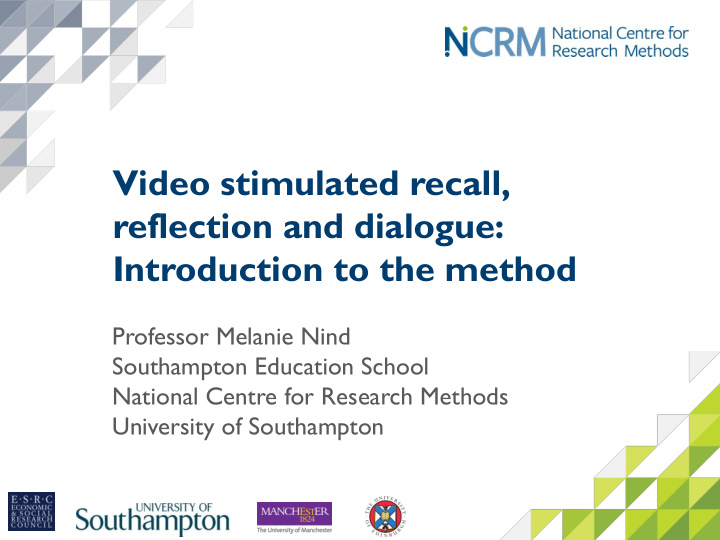



Video stimulated recall, reflection and dialogue: Introduction to the method Professor Melanie Nind Southampton Education School National Centre for Research Methods University of Southampton
An introduction to: • What the method involves • When and why the method might be useful • Some key decisions and challenges • Some ethical issues • How we in NCRM are benefitting from the method • (and the kinds of questions you need you ask yourself)
What the method involves • A retrospective think aloud advanced interview technique • Designed to enable the interviewee to relive an original situation - with vividness and accuracy – through being presented with a stimulus from the original situation – in this case a video • Perhaps prompting reflection & dialogue as well as recall • The video is not the (primary) subject of the analysis; it is the talk that is generated that is analysed • What are you wanting to be relived and why? • What stimulus would be sufficient for you?
When and why? • When you want to probe what happened, how the interviewee felt, why they made the choices they made... • To make visible what is hard to see and hard to know – to researchers and to participants • To combine data about participants’ actual behaviour and the thinking that comes with that behaviour – which can be complex, automated, and difficult to access (Lyle 2002) – Is this of benefit to you?
Video stimulated dialogue in action [A short except selected by the research team is played] Researcher 1: I think, well Melanie will probably say more about this than me, but I think we’re interested in that in particular because it was one of the moments [when] you’re quite engaged ... Researcher 2 (Melanie): There was nodding then, for the tape … it wasn’t very long ago [laughter] do you recall that moment? Participant (Liz, a learner): Actually I disagreed very strongly with what was being said, but perhaps, I don’t know if that came across that I did. Well I didn’t say, I didn’t say ‘I strongly disagree’. 5
Some key decisions 1. What kind of stimulus will work best? ( audio, photo, video -temporal, sequential, multimodal, engaging cues) What are the disadvantages of video? 2. What does the camera need to see? (angles, zoom, soundscape) 3. When and how to share the stimulus? (immediate/delayed; together/separate; interview/focus group) 4. Who chooses the excerpts for probing?
Some challenges 1. Capturing the video - being unobtrusive and gaining data of sufficient quality 2. Sharing the video – single picture/‘picture -in- picture’/‘split - screen’/raw/edited – quality of playback equipment See http://eprints.ncrm.ac.uk/3599
Some ethical issues • Is it ok to position people as the subjects of our professional/research gaze? • Or should we be reflecting together and avoiding evaluative judgement? • Who controls the process – of deciding what should be filmed & how, who selects the video and decides on the focus of the questions etc? • What feelings of ownership or vulnerability are we generating?
Using the method in NCRM • Teasing out pedagogical content knowledge – the hard to know in classroom interaction • Getting at complexity & making the implicit explicit • Facilitating dialogue about the process and effects of pedagogical decision-making • Learning for our shared and distinctive purposes • Flagging up discrepancies between what we think we are seeing and the participants’ explanations
Prompting reflection “Yeah , I think I just quite like the fact it felt quite conversational, I felt quite relaxed at that point when I suppose there was some comments that were feeding on from other members; it wasn’t like I was always asking the questions. It felt like it was really interesting, lots of interesting questions .” (Teacher in Nind, Kilburn & Wiles, 2015) 10
But … • Recall doesn’t always need to be stimulated! • It can be hard to find the most provocative moments • Lived experience does not always translate into video • Video becomes part of the interaction – a response as well as a trigger
Recommend
More recommend